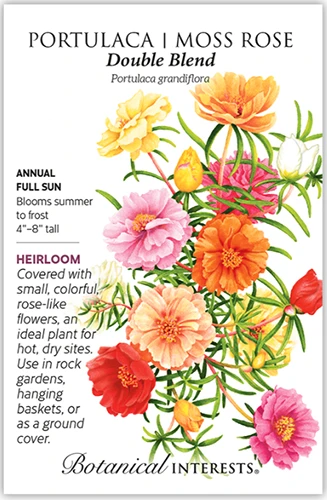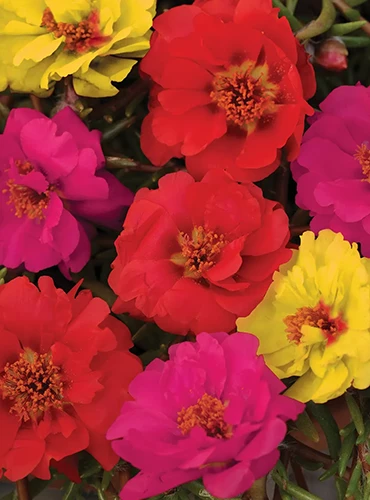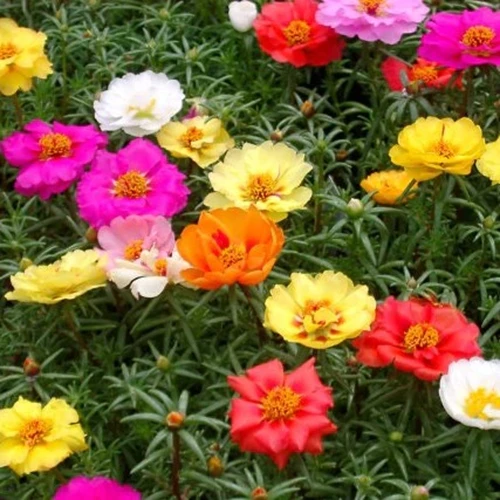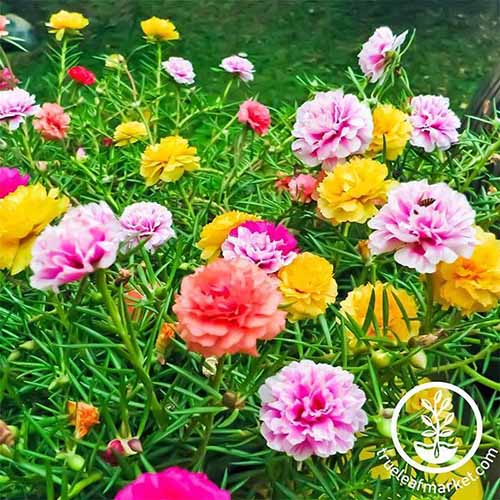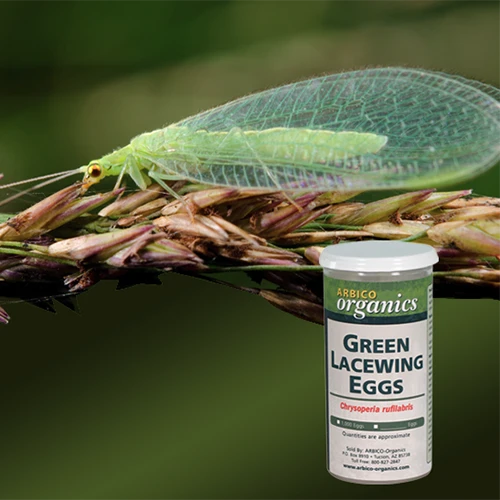Portulaca grandiflora
With showy and colorful rose-like flowers from June to first frost, Portulaca grandiflora, or moss rose, is a favorite for its easy cultivation and fast growth.
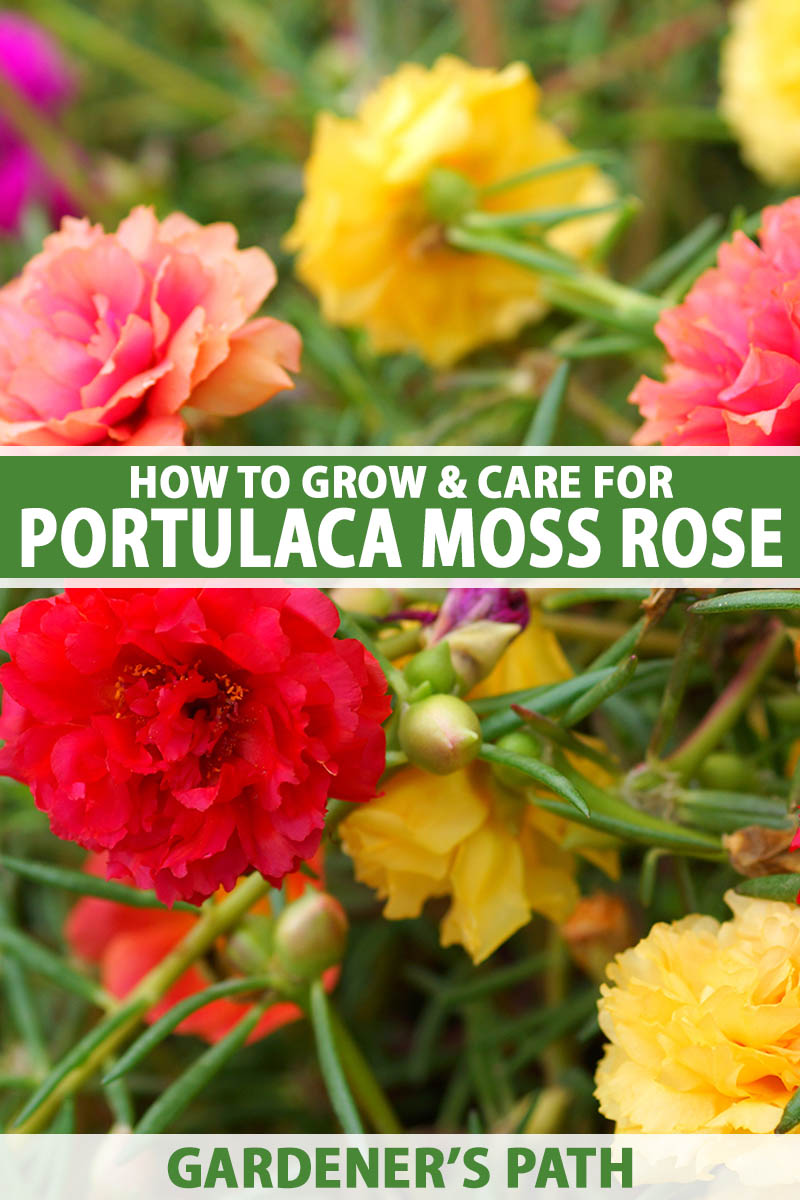
We link to vendors to help you find relevant products. If you buy from one of our links, we may earn a commission.
A bright and beautiful sun-loving plant for borders, containers, and edging, these tough succulents are also drought and heat tolerant – which makes them an excellent choice for rock gardens and xeriscapes or as a ground cover for hot, dry areas.
The single or double flowers come in pastel shades or intense hues of mauve, orange, pink, red, white, or yellow with petals of a delicate crinkly texture.
Closely related to common purslane (P. oleracea), portulaca is highly useful in poor soils where other plants struggle, and handy as a fast grower for filling in bare spots.
And it’s highly attractive to pollinators such as bees and butterflies but is left alone by the likes of deer and rabbits.
Resilient and built for heat, are you thinking your garden needs some moss rose this summer?
Then join us now for all the details on how to grow portulaca!
Here’s everything we’ll go over up ahead:
What You’ll Learn
What Is Portulaca?
Moss rose, Portulaca grandiflora, is a succulent species of flowers in the Portulacaceae family.
Multi-branched and low-growing, the rose-shaped flowers grow on terminal tips and are held above prostrate stems in small clusters.
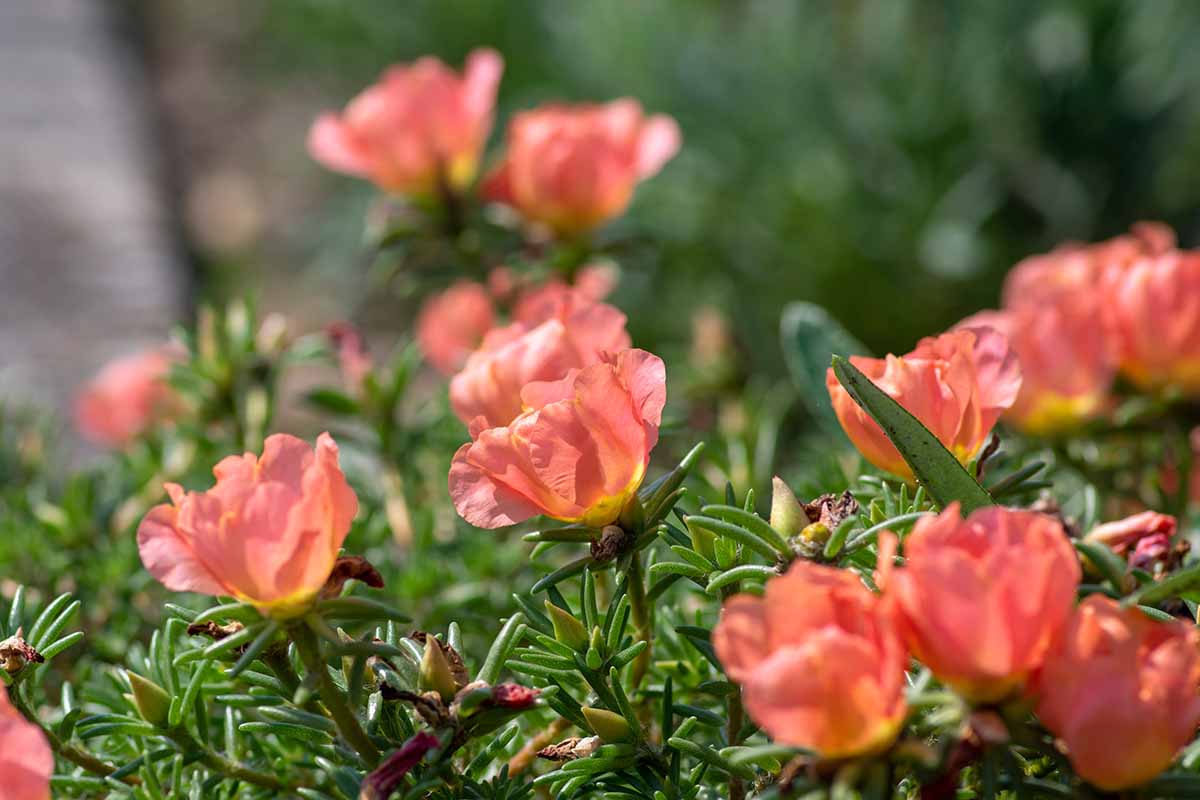
The light green, needle-like leaves are plump and fleshy for water storage.
Flowers measure up to one and a half inches wide with single or double, crepey petals surrounding clusters of bright yellow anthers.
Moss rose comes in richly saturated colors of fuchsia, magenta, mauve, orange, salmon, peach, pink, red, purple, white, and yellow, with some bicolors that have contrasting splashes and splotches.
And there are also cultivars in the same palette but in more subdued, pretty pastel shades.
These fast-growing succulents have a creeping or trailing habit. They grow up to nine inches and can spread up to 24 inches, but 12 to 14 inches is more common.
Some compact varieties have a tidier form, growing six to eight inches tall with an eight-inch spread.
With species plants, the flowers are nyctinastic, meaning they only open in bright sunlight, then close at night and remain closed on cloudy days. However, most of the newer hybrids are bred to remain open even with cloud cover.
After flowering, small kernel-like seed pods form containing tiny black seeds that disperse freely once ripe, reseeding in favorable conditions.
It should also be noted that portulaca contains calcium oxalates which can be toxic to cats, dogs, and horses.
Cultivation and History
Moss rose, also called Mexican rose, portulaca, rock rose, purslane, sun rose, and eleven o’clock flower – for its punctual habit of opening at 11 a.m., when the sun is high in the sky – are native to the rolling plains of Argentina, southern Brazil, and Uruguay.

This species has escaped cultivation in many areas and naturalized in mild regions of the Americas, Australia, Europe, and other frost-free locations.
The genus name Portulaca derives from the Latin word for little door (portula) and is thought to refer to the way seed pods open, like a flip-top.
The species epithet, grandiflora, is a combination of Latin words meaning large flowered.
Grown as an ornamental annual in temperate areas, moss rose is hardy only in USDA Zones 10 to 12.
Most seeds are sold in packets as colorful blends and mixes in single or double flowering forms.
And unlike other Portulaca species, such as P. oleracea and P. umbraticola, moss rose is not considered edible because of its bitter taste.
Portulaca Plant Propagation
Moss rose is easily propagated by sowing seed or rooting cuttings.
From Seed
Seeds can be sown early indoors and transplanted out once nighttime temperatures remain above 60°F, or direct sown in the garden. Blooms appear about 45 days after sowing.
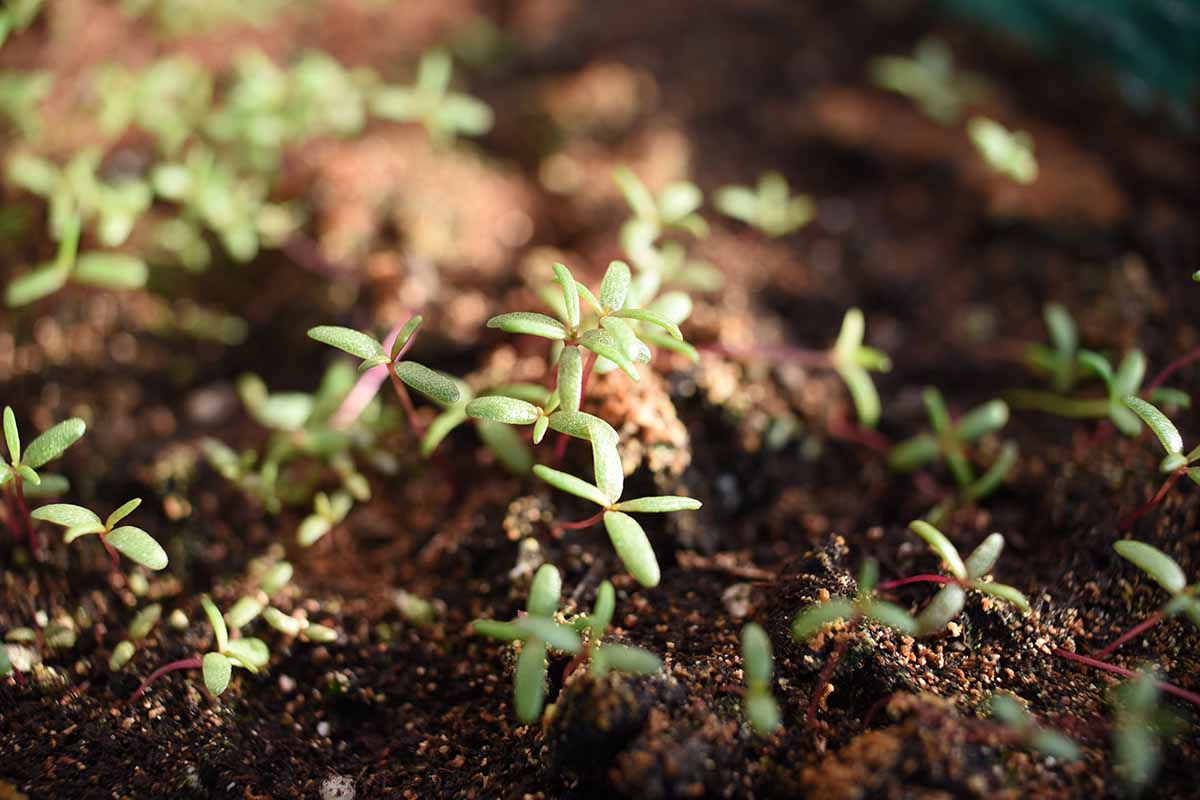
To start seeds indoors, sow six to eight weeks before the last frost in your area.
Fill seed cells, trays, or small pots with a finely textured compost or starter soil mix.
Carefully scatter the small seeds over the soil and just barely cover with one-eighth of an inch of soil – go easy with the cover soil as they need some light to germinate.
Water lightly and place trays in a bright location. Maintain temperatures of 70 to 75°F.
Keep the soil lightly moist and seeds will germinate in seven to 21 days.
Once seedlings have two sets of leaves, thin plants to one per cell or three inches apart.
When the seedlings are three to four inches tall, harden them off for at least one week by placing them in a sheltered spot with afternoon shade for increasing amounts of time each day.
Hardening off helps to toughen plants and reduces the chance of transplant shock and sun scald.
To direct sow outdoors, wait until soil temperatures reach 65°F.

Clean and rake well-draining soil amended with compost or manure. Add granite chips, landscape sand, or pea gravel to improve drainage if needed.
Scatter the tiny seeds evenly over the soil surface – mixing the small seeds with landscape sand can help to distribute them more evenly.
Barely cover the seeds with soil and water gently. Keep the soil moist until they germinate.
Once seedlings have two sets of leaves, thin to three inches apart. As the plants mature and spread, thin to 12 inches apart.
From Cuttings
Take four-inch cuttings from the outside perimeter of plants, choosing nonflowering stems.

Pinch out spent flowers or seed heads and remove leaves from the bottom half of each cutting. Dip in rooting hormone if desired.
Fill four-inch pots with a moist, finely textured compost or starter soil.
Insert stems up to the first set of leaves and firm the soil gently around them before watering lightly.
Place pots outdoors in a bright, protected location with afternoon shade and keep the soil lightly moist. Roots should form within seven to 14 days.
After new growth appears, gradually move plants into full sun then plant out in containers or the garden.
How to Grow Moss Rose
Moss rose gives the best performance when grown in a full sun location in humus-rich, well-draining soil with a gritty or sandy texture, and slightly acidic to neutral pH of 5.5 to 7.0.

Once established, plants do well in dry, lean soils, but they flower best if planted in humus-enriched soil and receive regular moisture.
Prepare the planting site by amending the soil with a shovelful of well-rotted compost or manure.
Mix in a shovelful of granite grit, landscape sand, or pea gravel to improve drainage if needed.
Stir in one or two tablespoons of bone meal for strong, healthy roots.
Set seedlings in place with the crown just below the soil surface and backfill, gently firming in place. Space 12 inches apart.
Water gently to settle, then water again when the top inch of soil is dry and allow the soil to dry thoroughly between water applications.
After plants are established, when they reach double their planting size, water only when the top two inches of soil dries out. The shallow root systems of moss rose are susceptible to root rot in wet soils.
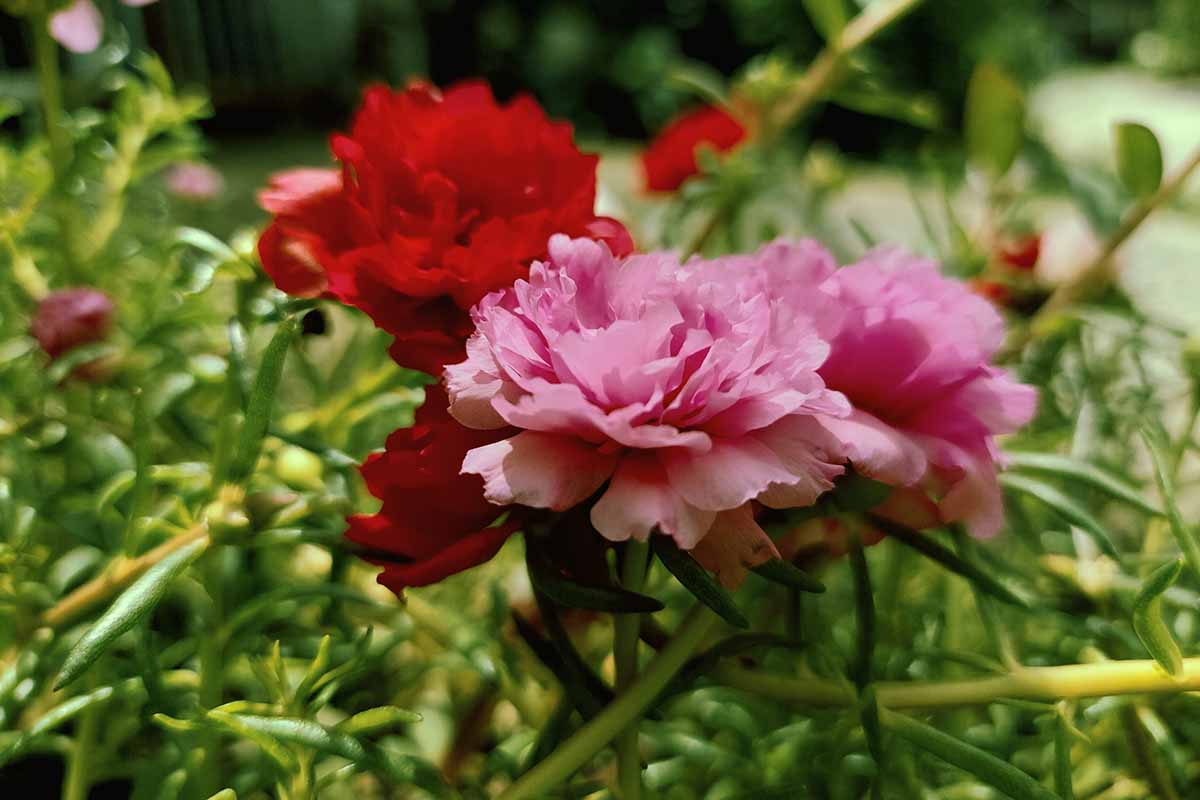
In areas with hot, dry soil, moss roses can go longer without water, but they take on a leaner, leggier form and produce fewer flowers as they get by on internal moisture stores – water as outlined for plump, floriferous plants.
For container growth, use pots and planters with drainage holes. I cover the holes with a two-inch layer of drainage materials such as broken pottery or pebbles.
Fill containers with a humus-rich and well-draining soil with a sandy or gritty texture.
Our succulent soil recipe is ideal for potted P. grandiflora. Mix in one or two tablespoons of bone meal to promote healthy roots.
Set plants in place and gently firm the soil over the root zone.
Place containers in a full sun location and water when the top inch or two of soil is dry.
For mixed container plantings, ensure all other plants have the same low water and full sun requirements.
Growing Tips
Moss rose is an easy-care species and the following tips help ensure productive, healthy plants.
- Ensure the soil is well-draining.
- Allow the top inch or two of soil to dry out between water applications.
- Plants are not heavy feeders and require little supplemental feeding if the soil has been enriched at planting time.
Pruning and Maintenance
At planting time, amend the soil with compost or manure as outlined in How to Grow above, or scatter a balanced, slow-release fertilizer over the soil.
Avoid overfertilizing, as this can result in lush foliage but fewer flowers.
A granular organic all-purpose plant food with a 5-5-5 NPK is available at Burpee.
A second feeding can be applied in midsummer if plants are grown in lean or poor soil.
Flowers are self-cleaning and don’t require deadheading but they can be removed to prevent unwanted self-seeding. Otherwise, seeds can be collected at any time throughout the summer as soon as they ripen.

Plants can be pruned in midseason should they become leggy or straggly. Use the trimmings to quickly start new plants.
Use clean, sharp scissors or shears to cut plants back by half for a tidy appearance and to promote full growth.
After pruning, apply a half-strength solution of a liquid or water-soluble fertilizer with a balanced formula, such as 10-10-10 NPK – use a half-strength solution so plants quickly produce new growth but don’t become lanky.
Avoid overwatering and wet soil which can cause root rot.
Moss Rose Cultivars to Select
P. grandiflora seedlings are readily available in the annuals section of your favorite garden center or you can purchase seed to start your own.
Seeds are most often sold in mixed blends of single or double flowers – the following selections all offer double blooms.
This Double Blend is a compact variety with flowers in brilliant colors of cherry, orange, red, rosy-pink, white, yellow, and pastels that grow four to eight inches tall and spread eight inches.
Seed packets are available at Botanical Interests.
The Color Carousel Mix has a trailing habit that features double flowers in fantastic shades of hot pink, scarlet, and sunshine yellow on plants growing six to nine inches tall and spreading 12 to 14 inches.
Packets of 50 seeds are available at Burpee.
Double Mix spreads and trails with flowers in bright shades of fuchsia, orange, scarlet, white, butter yellow, and sunshine yellow. Plants grow up to eight inches tall and spread 12 to 14 inches.
Seeds are available at Eden Brothers in a variety of packet sizes.
This Dwarf Double Mix has flowers in canary, carmine, ivory, fuchsia, peach, and salmon, growing three to nine inches tall and six to 12 inches wide.
Seeds are available from True Leaf Market.
Managing Pests and Disease
Moss rose is mostly problem-free, but there are a few issues to be on the lookout for.
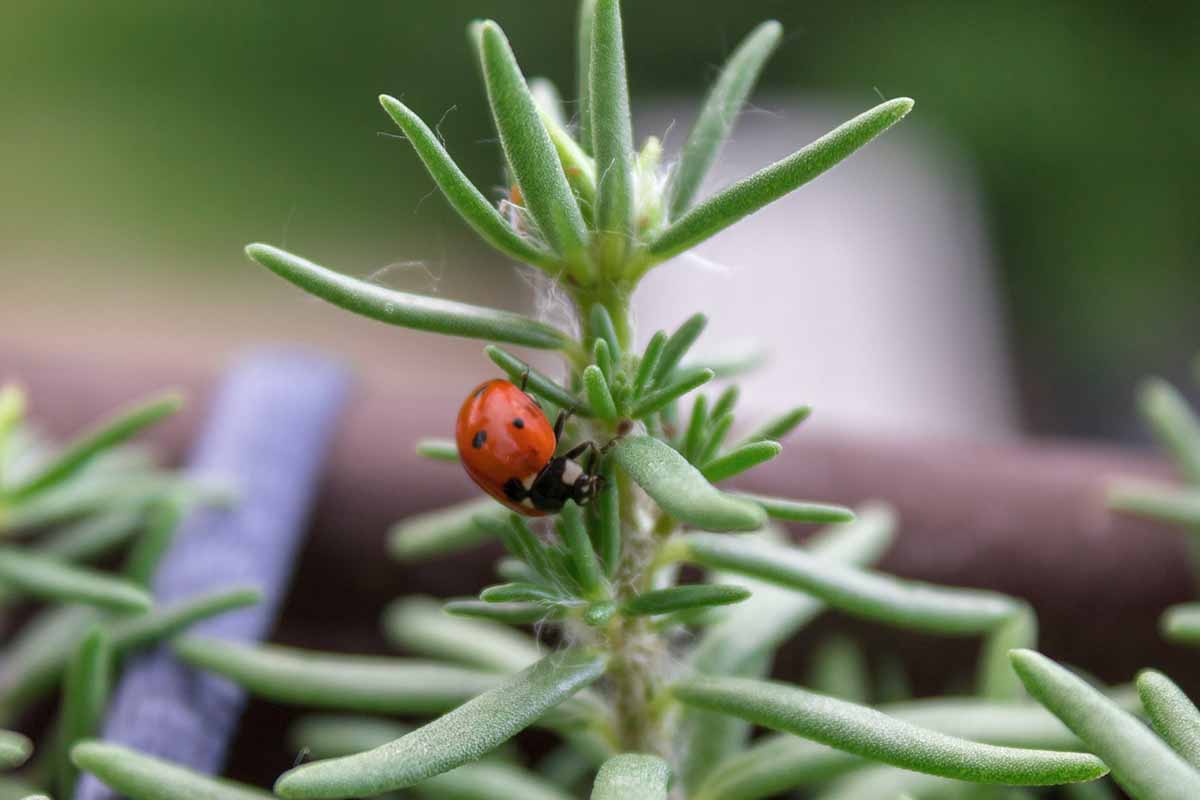
Sap-sucking aphids are the most common insect problem, causing yellow foliage and overall plant decline.
A strong spray from the garden hose is usually enough to get rid of them.
You can also use predatory insects like ladybugs and green lacewings for aphid control, or an insecticidal soap for persistent infestations.
Green lacewing eggs are available at Arbico Organics.
Slugs and snails can also cause damage as they chew through leaves and foliage.
Locate plants in full sun to minimize visits from slugs and snails, and handpick to dispose of any you see. You can find plenty more tips for dealing with these hungry gastropods in our guide on how to protect your garden from slugs and snails.
Generally disease-free, root and stem rot can be a problem in wet soil.
Ensure plants are grown in well-draining soil and allow it to dry to a depth of one to two inches between water applications.
Best Uses for Portulaca Flowers
Moss rose makes a bright and durable choice as a bedding plant or seasonal ground cover.
These plants make a bold statement when massed as an edger in beds and borders, and being heat lovers, they make a smart choice for bordering heat-absorbing areas like asphalt, bricks, and concrete.

Fast growing, they’re excellent when interplanted with spring bulbs, quickly filling in bare areas with color as the bulbs die back.
The creeping, colorful habit makes a pretty choice for tucking between rocks, flagstones, and pavers, or stuffing into cracks in a rock wall. Note that they cannot handle foot traffic.
Moss rose makes a sensational trailer, dripping bright colors over the edge of hanging baskets, patio pots, and window boxes or cascading down rockeries and over retaining and rock walls.
Their drought tolerance makes this species a natural for bare or hot areas where other plants struggle and in xeriscapes as well.
Use standard size varieties for trailing, spreading, or spilling and the compact ones for stuffing and tucking.
Quick Reference Growing Guide
| Plant Type: | Flowering succulent | Flower / Foliage Color: | Mauve, orange, pink, red, white, yellow/ light to mid-green |
| Native to: | South America | Water Needs: | Low |
| Hardiness (USDA Zone): | 10-12, annual in other regions | Tolerance: | Deer, drought, lean soil, rabbits |
| Bloom Time/Season: | Summer | Maintenance: | Low |
| Exposure: | Full sun | Soil Type: | Lean to humus-rich and gritty |
| Time to Maturity: | 45 days (from seed0 | Soil pH: | 5.5-7.0 |
| Spacing: | 10-12 inches | Soil Drainage: | Well-draining |
| Planting Depth: | 1/8 inch (seeds), crown just below soil surface (transplants) | Attracts: | Bees, butterflies |
| Height: | Up to 9 inches | Uses: | Containers; cut arrangements; gravel, rock, and xeriscape gardens; naturalized settingBorders, containers, edging, rock gardens, low irrigation and xeriscape gardens |
| Spread: | 8-20 inches, depending on cultivar | Family: | Portulacaceae |
| Growth Rate: | Fast | Genus: | Portulaca |
| Common Pests and Diseases: | Aphids, slugs, snails; root rot, stem rot | Species: | Grandiflora |
Colorful and Easy
Fast growing, brightly colored, and drought tolerant, moss rose is an excellent choice for many garden settings.
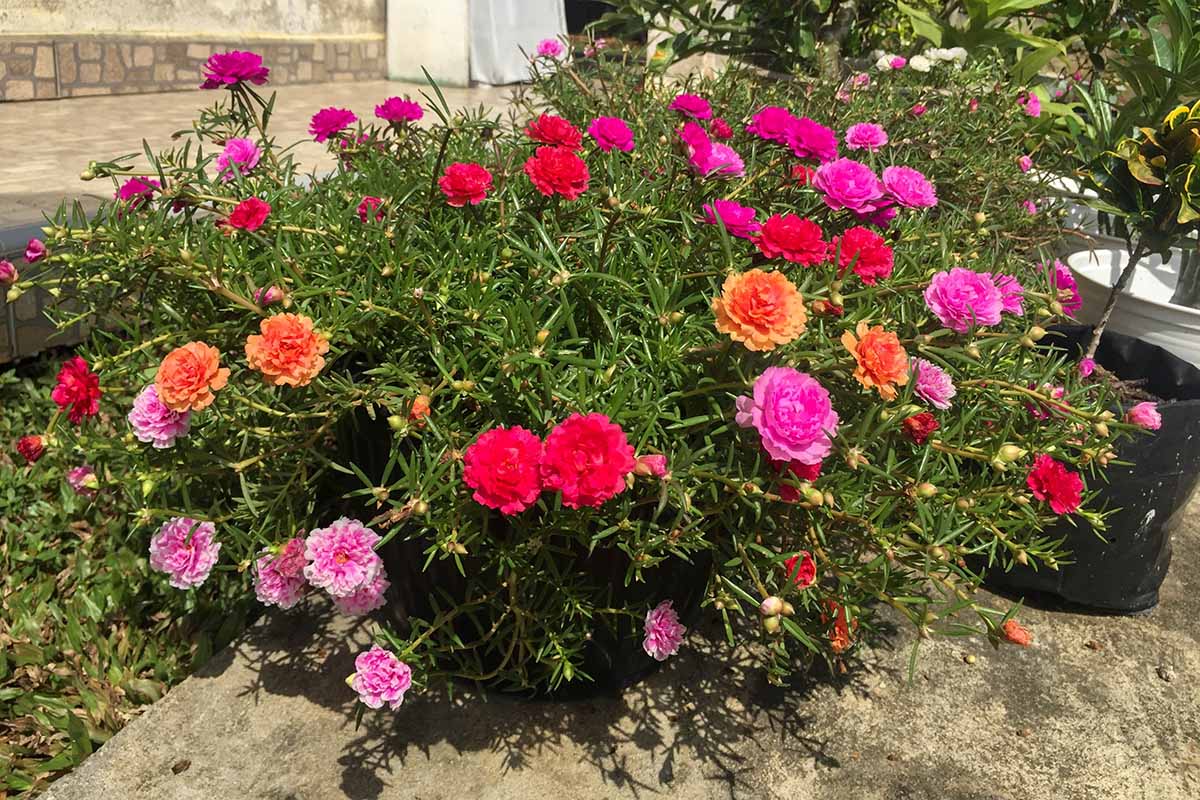
These easy-care annuals aren’t demanding as long as they’re planted in well-draining soil with full sun. And they can also be grown as perennials in Zones 10 to 12.
Give them these conditions, and you’ll enjoy flowers all summer long – even in the hot, dry spots where nothing else grows!
How do you use P. grandiflora in the garden? Tell us about it in the comments section below.
And for more info on fast-growing, colorful annuals, be sure to read these guides next.

